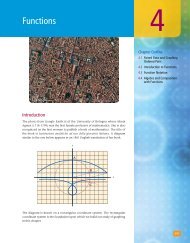Chapter 9 - XYZ Custom Plus
Chapter 9 - XYZ Custom Plus
Chapter 9 - XYZ Custom Plus
You also want an ePaper? Increase the reach of your titles
YUMPU automatically turns print PDFs into web optimized ePapers that Google loves.
9.1 The Distributive Property and Algebraic Expressions<br />
515<br />
Example 11<br />
Find x in each of the following diagrams.<br />
a. b.<br />
x<br />
30°<br />
x<br />
45°<br />
Supplementary angles<br />
11. Find x in each of the following<br />
diagrams.<br />
a.<br />
x<br />
45°<br />
Solution<br />
Complementary angles<br />
We use subtraction to find each angle.<br />
a. Because the two angles are complementary, we can find x by<br />
subtracting 30° from 90°:<br />
x 5 90° 2 30° 5 60°<br />
Complementary angles<br />
b.<br />
x<br />
60°<br />
We say 30° and 60° are complementary angles. The complement<br />
of 30° is 60°.<br />
Supplementary angles<br />
b. The two angles in the diagram are supplementary. To find x, we<br />
subtract 45° from 180°:<br />
x 5 180° 2 45° 5 135°<br />
We say 45° and 135° are supplementary angles. The supplement<br />
of 45° is 135°.<br />
Using<br />
Protractors<br />
Technology<br />
When we think of technology, we think of computers and calculators. However,<br />
some simpler devices are also in the category of technology, because<br />
they help us do things that would be difficult to do without them. The protractor<br />
below can be used to draw and measure angles. In the diagram below,<br />
the protractor is being used to measure an angle of 120°. It can also be used<br />
to draw angles of any size.<br />
140<br />
40<br />
130<br />
50<br />
60<br />
120<br />
110<br />
70<br />
80<br />
100<br />
90<br />
90<br />
100<br />
80<br />
110<br />
70<br />
120<br />
60<br />
130<br />
50<br />
140<br />
40<br />
150<br />
30<br />
160<br />
20<br />
120°<br />
150<br />
30<br />
160<br />
20<br />
170<br />
10<br />
170<br />
10<br />
0<br />
180<br />
180<br />
0<br />
0 12345678910 11<br />
If you have a protractor, use it to draw the following angles: 30°, 45°, 60°,<br />
120°, 135°, and 150°. Then imagine how you would draw these angles without<br />
a protractor.<br />
Answer<br />
11. a. 45° b. 120°

















